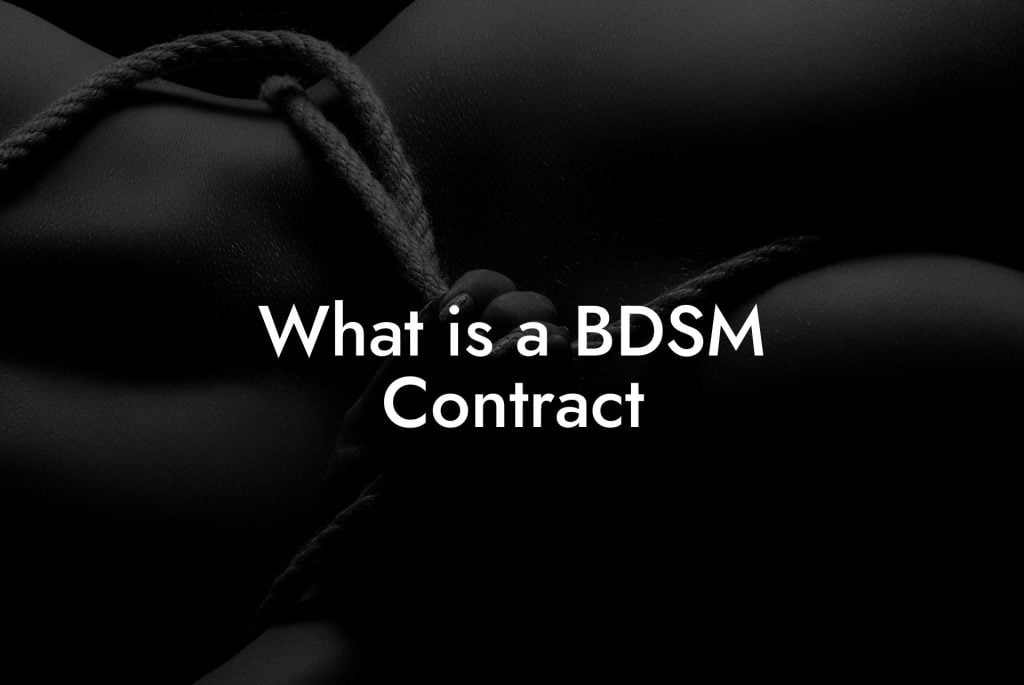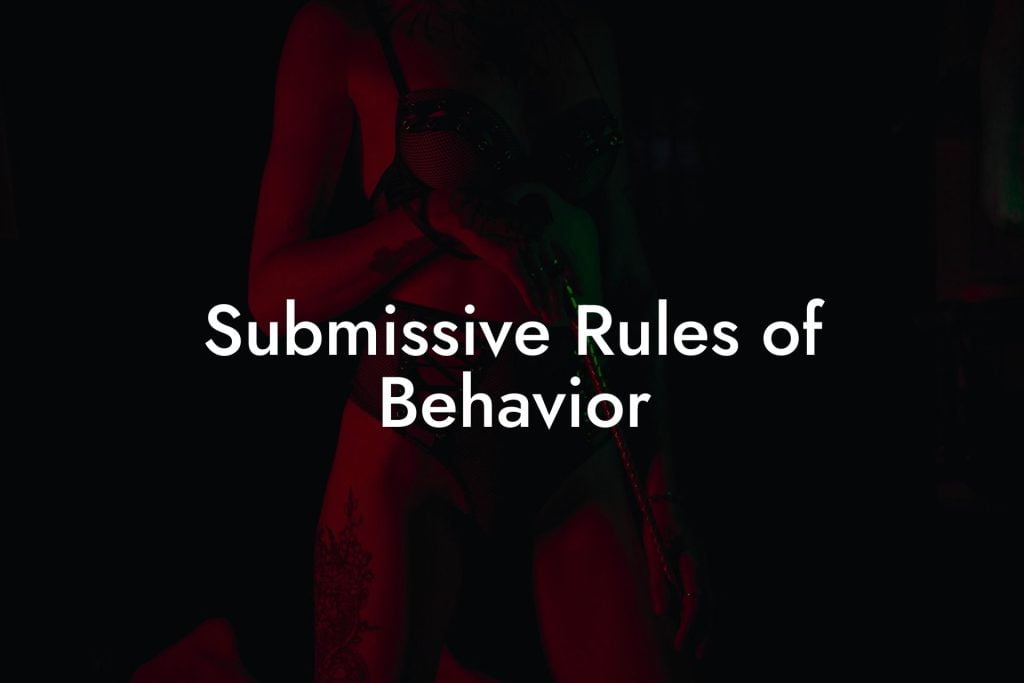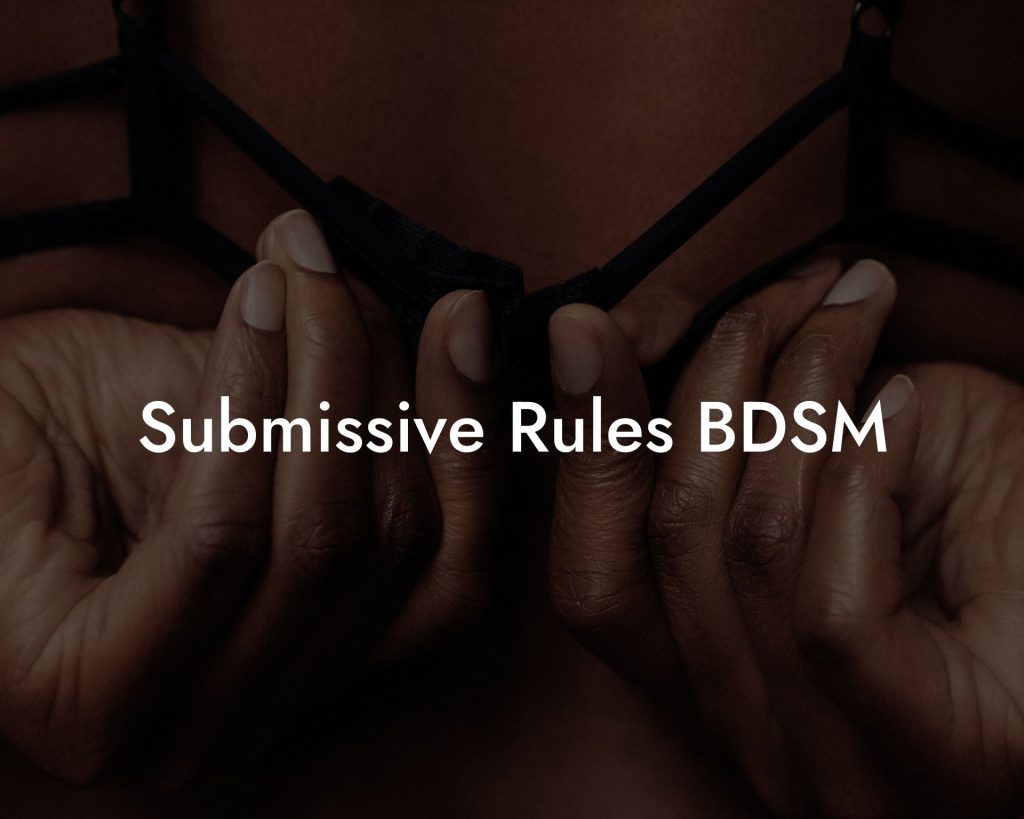BDSM is a realm of pleasure and power exchange that has gained considerable popularity in recent years. However, it is essential to understand that within this world, boundaries play a crucial role. Without clear boundaries, it can be challenging to navigate the depths of pleasure and ensure all parties involved feel safe and respected. In this comprehensive guide, we will delve into the concept of BDSM limits, exploring what they entail and how they contribute to enriching experiences of power dynamics and pleasure.
In any BDSM relationship, consent is the cornerstone of trust and respect. It’s more than just saying “yes” or “no”—it’s about openly communicating your desires, limits, and expectations. But trust doesn’t end with a conversation—it’s built through ongoing, clear agreements. That’s where our Dominant & Submissive BDSM Contract Pack comes in. Find out more →
BDSM Limits Understanding the Basics
To embark on a fulfilling BDSM journey, it is vital to understand the concept of limits. Limits are the boundaries that define the activities, roles, and scenarios an individual is comfortable with during BDSM play. These boundaries vary from person to person and can encompass a vast array of preferences, desires, and experiences. As we explore BDSM limits, we will discuss the importance of communication, consent, and safe words to ensure a mutually satisfying experience.
Prioritizing Communication and Consent
Open communication and enthusiastic consent are the cornerstones of a healthy and fulfilling BDSM dynamic. It is crucial to establish a safe space where all participants can openly discuss their desires, limits, and boundaries. Effective communication helps ensure that everyone involved can engage in activities that align with their comfort levels and provides an avenue for ongoing consent throughout the experience.
Exploring Soft Limits and Hard Limits
Within the realm of BDSM, there are two types of limits: soft limits and hard limits. Soft limits refer to activities an individual may be hesitant about but are open to exploring under specific conditions. Hard limits, on the other hand, are activities or scenarios that are off-limits, non-negotiable, and should never be crossed without explicit consent. Understanding these distinctions is paramount to establishing trust and respect within a BDSM relationship.
Negotiating and Expanding Boundaries
In the world of BDSM, boundaries are not static and can evolve over time. The process of negotiating and expanding these boundaries is known as "limit pushing." Limit pushing involves open and ongoing communication, checking in with partners regularly, and exploring new experiences within the agreed-upon boundaries. This allows individuals to push their limits gradually and safely while ensuring absolute consent and comfort.
Looking for the best BDSM & Kink OnlyFans content creators? Here is a list of of our favourites that you will love:
-
- Best BDSM & Fetish OnlyFans - Molly✨ >> Link
- Best BBW & Huge Ass OnlyFans - Naughty Hanna Zimmer 💜🎀 >> Link
- Best Sexy Gaming Nerd OnlyFans - 🎮 Gracy EstuSWEET 🎮 >> Link
- Best Fetish & Kink Messaging OnlyFans - 💫Lola La Fleur 💫 >> Link
- Best Girl Next Door OnlyFans - ☀️Lily ⛅ >> Link
- Best Tiny European OnlyFans - 💝 Ami Allison 💝 >> Link
- Best Cosplay OnlyFans - 🐱 Little Kitty Kate 👉👌 >> Link
- Best Little OnlyFans - 🧸 Katya 🙇♀️ Sun >> Link
- Best Sub OnlyFans - 🍌Hanna Banana🍌 >> Link
- Best Teen & Huge Tits OnlyFans - ❣️Anny❣️19 y.o. BUSTY student girl >> Link
- Best Tiny Tits OnlyFans - ⍣⭐️ Sofia Parker ⭐️⍣ >> Link
- Best Sub & Huge Boobs OnlyFans - Nika Huge Boobs >> Link
- Best Kink OnlyFans - Sofia💖 >> Link
- Best Fetish & Girl Next Door OnlyFans - Hillary is Wet 💦 >> Link
- Best Dirty Latina OnlyFans - Paula Flores 😈 >> Link
Not quite what you are looking for? View the full list →
Frequently Asked Questions
What is a BDSM contract?
A BDSM contract is a written agreement between consenting adults that outlines the roles, responsibilities, limits, and expectations of each party involved in a BDSM relationship. This contract helps to establish boundaries and ensure that all parties understand and consent to the terms of their power exchange or play sessions. While not legally binding, it's a tool used to enhance communication and foster trust.
Why is consent so important in BDSM?
Consent is the cornerstone of all interactions in BDSM. It ensures that all parties involved have a clear understanding of what is to happen, agree to the activities, and have the ability to communicate their boundaries and limits. Consent must be informed, voluntary, and revocable at any time to maintain safety and respect within the dynamic.
How do BDSM power dynamics work?
BDSM power dynamics involve an exchange of power between consenting adults, where one person (the dominant) takes more control and the other (the submissive) gives up some control within agreed limits. These dynamics can manifest in innumerable ways, and are as unique as the individuals involved.
Can BDSM contracts be changed?
Yes, BDSM contracts can and should be revisited and revised as the relationship evolves or as the needs and boundaries of participants change. They are living documents that reflect the current state of the relationship and should be adjusted accordingly.
What is the difference between a scene and a relationship in BDSM?
A 'scene' in BDSM typically refers to a specific period of play that involves a set of agreed-upon activities. A BDSM relationship, on the other hand, refers to an ongoing interpersonal relationship that includes power dynamics and may or may not involve scenes.
How do you negotiate a BDSM scene?
Negotiation in a BDSM scene involves discussing and agreeing on various aspects such as roles, activities, limits, safewords, and aftercare, before the scene takes place. Effective negotiation requires honesty, clear communication, and respect for each other's boundaries and desires.
What are safewords and how are they used?
Safewords are predetermined words or signals used by participants to communicate during a scene, often to pause or stop the action. They are crucial for maintaining safety and respecting boundaries, and they allow for clear communication even in the heat of the moment.
How can trust be built in a BDSM relationship?
Trust in a BDSM relationship is built through open communication, respecting boundaries and limits, consistent follow-through on agreements, and taking responsibility for each other's safety. It is an ongoing process that requires both parties to be honest and vulnerable with each other.
Is a BDSM contract legally enforceable?
No, BDSM contracts are not legally enforceable. They are symbolic agreements that reflect the desires and consents of the parties involved. The value lies in the clarity and trust they build, not in legal enforceability.
What should be included in a BDSM contract?
A BDSM contract should include the names of the parties involved, their limits, roles, safewords, duration of the contract, expectations, rules and punishments, privacy agreement, and any other aspects relevant to their dynamic. Clarity and detail can help prevent misunderstandings.
How does one approach the topic of a BDSM contract with a partner?
Approach the topic of a BDSM contract with your partner by expressing your desires to have clear communication and mutual understanding of boundaries and expectations. Ensure it's a collaborative conversation where both parties can share their thoughts and concerns openly.
Can someone withdraw consent during a BDSM scene?
Absolutely. Consent can be withdrawn at any point during a BDSM scene. When consent is revoked, all activities should cease immediately, and partners should engage in a discussion about what triggered the withdrawal and how to proceed.
What is aftercare and why is it important?
Aftercare refers to the care and attention given to participants following a BDSM scene. It can involve physical care, emotional support, or a combination of both, to help the individuals recover and reconnect. Aftercare is crucial because it ensures the well-being of all parties after the intensity of the experience.
Do all BDSM activities require a contract?
No, not all BDSM activities require a contract. Some participants may choose to use contracts for long-term dynamics or more intense scenes, while others rely on thorough communication and explicit verbal consent. Whether to use a contract is a personal choice and should be agreed upon by all parties involved.
How does one enforce rules within a BDSM contract?
Enforcing rules within a BDSM contract relies on the honesty and integrity of the individuals involved. Consequences for breaking rules should be outlined in the contract and should always be safe, sane, and consensual. Holding each other accountable is key to maintaining the dynamic.
Are BDSM contracts only for 'extreme' play?
BDSM contracts are not reserved for 'extreme' play only; they can be useful for any level of BDSM involvement. They serve to create a shared understanding and ensure safety and consent regardless of the intensity of play.
Is it necessary to have a witness or a third party involved when signing a BDSM contract?
Having a witness or third party is not necessary when signing a BDSM contract, though some may choose to have one for their personal comfort or as part of their dynamic. It can help to reinforce the seriousness of the agreement for all parties involved.
Can people new to BDSM engage in contracts?
People new to BDSM can absolutely engage in contracts. In fact, contracts can be particularly useful for novices as they provide a structured framework that outlines expectations and boundaries clearly, helping to guide them through their initial exploration.
How can individuals ensure their safety when exploring BDSM?
To ensure safety when exploring BDSM, individuals should educate themselves about the practices, negotiate clear boundaries and limits, use safewords, engage in consistent and honest communication, and vet potential partners carefully. Remember to prioritize consent, trust, and mutual respect.
What if my partner doesn't want to sign a BDSM contract?
If your partner doesn't want to sign a BDSM contract, it's important to have a thorough conversation about how you will communicate and ensure consent and safety. Respect their decision and seek to understand their perspective. Effective communication is always key in BDSM dynamics.
Can BDSM contracts help in resolving conflicts?
BDSM contracts can assist in resolving conflicts by providing a reference point for what was initially agreed upon. They can help to clarify misunderstandings and serve as a basis for renegotiating terms if necessary. Remember that communication and willingness to adjust are essential for conflict resolution.
In conclusion, BDSM represents a world of pleasure, exploration, and power dynamics. Establishing and respecting limits is vital for creating a safe and fulfilling experience for all involved. By openly communicating boundaries, negotiating consent, and exploring limits at a comfortable pace, individuals can embark on a journey that pushes the boundaries of pleasure while maintaining trust and respect. Discover more informative guides, explore our range of fetish products, and order our Ultimate BDSM Contract Pack to enhance your BDSM experience. Share this valuable article with others who are curious about BDSM and embrace the power of exploration within the world of kink.













